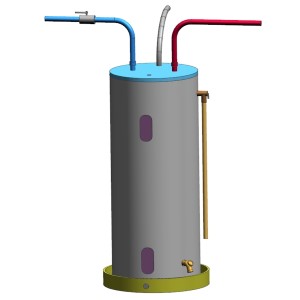- Home
- Water Tank Heater
- Temperature and Pressure Relief Valve
Temperature and Pressure Relief Valve
Installation and Replacement Tips
How to replace a temperature and pressure relief valve (TPR) in water heaters – a step-by-step guide. Find out how the T&P relief valve, as the safety component, brings you reliable water heating and what you should do to keep it operational. Is you hot water leaking? Check the TPR valve. Check out the problems related to the valve malfunction.
Highlights
What is a temperature and pressure relief valve?
 Electric water heater
Electric water heaterThe temperature and pressure relief valve (TPR or T&P) is the safety device found on all types of water heaters and is designed to prevent water from boiling or overheating.
If the T&P relief valve is not installed, there will be a lot of stress on the water heater caused by the extreme pressure and temperature, which might cause the deformation and rupture of the unit.
Note: Almost every water tank heater has the temperature and pressure relief valve factory installed, while on tankless appliances, PRV or pressure relief valve is recommended.
The T&P relief valve is mainly installed on the side of the heater (the upper part) and should be immersed in the top six inches of the heater.
How does a T&P valve work?
As said, a TPR valve is factory installed on almost all water tank heaters and is designed for pressures up to the maximum of 150 PSI in residential applications. A TPR is also designed to open when the pressure inside the tank exceeds this value or if the temperature exceeds values close to the boiling of (212 F).
Also, it is recommended to install a discharge pipe on every TPR valve (and terminate at least 6" above the floor), which will direct the excessive vapor or hot water down to the floor drain.
Keep in mind that any discharge means unsafe conditions inside the water heater, so you should always contact the technician.
Problems and how to avoid them
The most dangerous situation is if a TPR valve doesn't work (open) and there are excessive pressure and temperature buildup inside the water heater.
The most frequent problem is related to the hard water and mineral deposits in the valve seat, which prevents it from closing tightly. Also, due to the thermal expansion in the closed water systems, you might see that the valve discharges or makes the popping noise periodically.
- Find Plumbers In Your Area -
Testing a TPR valve
The problems mentioned above are the reasons why a temperature and relief valve has to be tested regularly.
Test the element by lifting and releasing the lever slowly and check does it open and closes freely. Allow several gallons of water to flush through the discharge line. If the relief valve fails to closes, and still releasing the water, shut the unit off and call a plumber to replace the element.
The valve should never be altered or repaired; always install a new one, which must be done per codes and with a sufficient rating (manufacturer recommended). There should be no obstruction between the valve and a tank.
How to replace a temperature and pressure relief valve
- Turn the power off (electricity and gas supply if applicable).
- Attached one end of the garden hose to the drain valve and terminate the other end outside or to the floor drain.
- Close the water supply on the shut-off spigot.
- Open the TPR valve, then open the drain spigot. Be careful as the water might be hot.
- Close the drain spigot when the water stops running.
- Remove the old T&P relief valve.
- Use a pipe sealer or Teflon tape on the threads and install the new valve. The T&P valve should be in the open position.
- Open the hot water tap and shut off valve on the cold water line.
- Close the relief valve once the water starts flowing in the steady stream.
- Turn the hot water tap off once the steady stream of water is established.
- Make sure the tank is full before running the heater. Turn on the power.
- Test the valve once again.
As said before, the temperature and pressure relief valve is the safety element that must work adequately anytime, while rated equal or higher than the working pressure (found on the rating plate), protected from freezing and without any obstructions, including the discharge pipe.
Related
- Check out the main parts in water heaters
- Anode rod - How to replace and install
- Dip tube - Replacing and installation tips
- Drain valve - What is it, how it works and installation tips
- Heating elements - Testing, installation, problems and solution
- Installing an insulation blanket
- TPR valve - How to replace
- Expansion tank - What is it, how does it work and installation
- Home
- Water Tank Heater
- Temperature and Pressure Relief Valve

